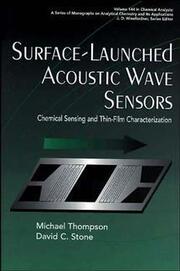Detailansicht
Surface-Launched Acoustic Wave Sensors
Chemical Sensing and Thin-Film Characterization, Chemical Analysis: A Series of Monographs on Analytical Chemistry and Its Applications
ISBN/EAN: 9780471127949
Umbreit-Nr.: 2083157
Sprache:
Englisch
Umfang: XX, 196 S.
Format in cm:
Einband:
gebundenes Buch
Erschienen am 23.04.1997
Auflage: 1/1997
- Zusatztext
- This book concerns the design, operation and application of devices capable of generating acoustic waves in the ultrasonic frequency range. It emphasizes the study of chemical and/or biochemical systems imposed on the surface of such devices, whether operated in the gas- or liquid-phase, i.e. on acoustic wave chemical and biological sensors. It focuses on devices that employ acoustic waves launched and received on the same surface. It touches upon such diverse areas as acoustic wave physics, applied mathematics, chemistry, electronics, fluid mechanics, materials science and polymer science.
- Kurztext
- With respect to chemical applications, surface-launched acoustic wave sensors were originally developed as sensing devices for specific chemical and biological species, but more recently have been applied to the study of thin film and interfacial properties. These devices exploit the phenomenon of piezoelectricity, the instigation of mechanical motion in solids by oscillating electrical fields. This text/reference presents the principles of design and operation of these sensors and explores their traditional and emerging applications with a focus on devices that employ acoustic waves launched and received on the same surface. The book begins with a review of piezoelectricity and the genesis of acoustic wave devices, and the advent of chemical sensor technology. Subsequent chapters explore acoustic waves in solids and device structure, theory of acoustic wave response, and the various categories of acoustic wave device. The book describes the design of these devices and how they are applied in chemistry for the detection of species present in the gas and liquid phase, as well as the study of thin films placed on the sensor surface. Other topics covered include polymeric glass transitions, polymer properties, biosensor technology, and the development of sensor arrays. Each of the various types of device is examined with a view toward its application in chemistry in general and analytical chemistry in particular. Presenting the most up-to-date information available on this rapidly evolving technology, and supplemented with scores of helpful illustrations and tables, Surface-Launched Acoustic Wave Sensors draws information from such diverse areas of scientific investigation as acoustic wave physics, applied mathematics, chemistry, electronics, fluid mechanics, materials science, piezoelectricity, and polymer science. The material presented on these topics is both self-consistent and readable for the nonexpert--allowing industrial chemists, graduate students, and undergraduates to gain a deeper understanding of these devices, their designs, and applications. A focused and accessible presentation of a burgeoning new technology This book concerns the design, operation, and application of devices capable of generating acoustic waves in the ultrasonic frequency range. The clear emphasis of the text is the study of chemical and/or biochemical systems imposed on the surface of such devices, whether operated in the gas or liquid phase, i.e., on acoustic wave chemical and biological sensors. Presenting the most up-to-date information available on this rapidly evolving technology, and supplemented with scores of helpful illustrations and tables, this book * Reviews piezoelectricity and the genesis of acoustic wave devices as well as the advent of chemical sensor technology * Explores acoustic waves in solids and device structure, theory of acoustic wave response, and the various categories of acoustic wave device * Describes device design and how these devices are applied in chemistry to detect species present in the gas and liquid phase, as well as to study thin films placed on the sensor surface * Covers polymeric glass transitions, polymer properties, biosensor technology, and the development of sensor arrays * Examines each of the various types of device with a view toward its application in analytical chemistry and chemistry in general
- Autorenportrait
- MICHAEL THOMPSON, DSc, is Professor of Analytical Chemistry at the University of Toronto. His research interests include the fundamental mechanisms of operation of acoustic wave devices in liquids, the development of biosensors in nucleic acid probe applications, sensor arrays and chemometric procedures, and biocompatibility of implant surfaces. Professor Thompson is a Fellow of the Royal Society of Chemistry and the Canadian Institute of Chemistry, and a member of the American Chemical Society and New York Academy of Sciences. He has served on the editorial advisory boards of several journals, including Talanta, Analytica Chimica Acta, Analytical Chemistry, The Analyst, and Biosensors & Bioelectronics. He is currently an editor of the Canadian Journal of Chemistry. DAVID C. STONE received his PhD in analytical science from Loughborough University in the United Kingdom, and did postdoctoral work at the University of Toronto. He is actively engaged in chemical sensor research and teaches chemistry at the University. His interests include instrumentation for chemical analysis, surface chemistry, and chemical sensor technology. He is a member of the Royal Society of Chemistry.
